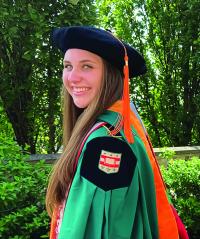Navigating the Physics-Filled Road To Engineering
Spring
2024
Member Spotlight
Navigating the Physics-Filled Road To Engineering
Korena Di Roma Howley, Contributing Editor
Graduation_headshot.jpg

Krista Sudar.
“I didn’t fully connect with the material and found it to be sometimes too abstract for my liking,” she says.
But after her induction into Sigma Pi Sigma, Sudar joined the SPS chapter at Washington and Jefferson College (W&J) in Washington, Pennsylvania.
“SPS and Sigma Pi Sigma allowed me to connect to other physics students at W&J,” Sudar says. “Once I declared as a physics major, got involved with SPS, and started meeting more people, I slowly started to build a network and feel more OK in the world of physics.”
As a first-year student, Sudar had known that she wanted to enter a STEM field and had enrolled in as many STEM classes as she could. Halfway through that year, she decided to pursue W&J’s engineering and applied science dual degree. She selected a program option that allows undergraduates to spend three years at W&J completing an engineering-related major, followed by another three years at a partner school taking both undergraduate and graduate classes in an engineering discipline. At the end of six years, students have two undergraduate degrees and a master’s degree.
Sudar enjoyed the physics classes she was taking at W&J and knew that a physics major would fulfill many of the requirements of the engineering degree she would pursue next. But physics didn’t come easy. Further into the major, she became uncertain about her course of study and questioned whether engineering would be right for her either.
Then she began her engineering program at Washington University in St. Louis.
“I quickly realized that I love engineering,” she says. “It’s the perfect blend of applying concepts to physical objects and systems.”
While at Washington University, Sudar became involved with the varsity track-and-field team and with the university’s rocketry design team. “I used rocketry as a way to get hands-on experience outside of the classroom and track as a way to escape school altogether,” she says. “I knew engineering was right for me when I would watch my teammates practice and wonder if there was a way to make the implements they were throwing more aerodynamic. My coach even started framing her throwing advice for me in terms of engineering concepts. I never grew tired of engineering, and it has become a part of my daily life now.”
Today, with undergraduate degrees in physics and mechanical engineering and a graduate degree in aerospace engineering, Sudar works as a mechanical/aerospace engineer in the Discovery Program at Johns Hopkins University’s Applied Physics Laboratory (APL). During this two-year program for recent college graduates, Sudar will rotate through different groups around the lab in order to get broad exposure to the work being done there.
“One of the things that drew me to the Discovery Program was that I had three degrees and no clue how I wanted to use them,” she says. “Rotating through the lab allows me to explore all the avenues and domains I’m interested in.”
In her first rotation, Sudar’s work involved aerospace engineering and computational fluid dynamics in the defense domain. Now in her second rotation, Sudar is working in systems engineering in the space domain. “Two very different experiences,” she says, “but both have allowed me to learn so much and contribute to multiple aspects of an engineering project. In future rotations, I’ll explore mechanical engineering groups around the lab, and I’m sure I’ll learn even more in the process.”
While in the program, Sudar hopes to pin down what she’ll do for the rest of her career. “There are many subdomains of mechanical and aerospace engineering, so my goal by the time I complete the Discovery Program at APL is to find where I can most meaningfully contribute,” she says. “My ideal work would be right at the intersection of mechanical and aerospace engineering. What exactly that looks like, I’m not sure right now—but I’m excited to find out.”
Learn more about the Johns Hopkins Applied Physics Laboratory Discovery Program for new and recent STEM graduates at careers.jhuapl.edu/jobs/53235.
